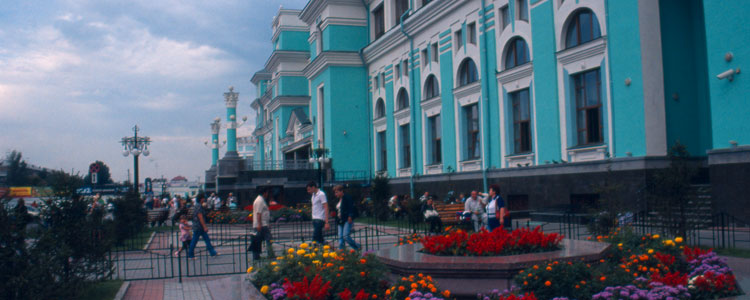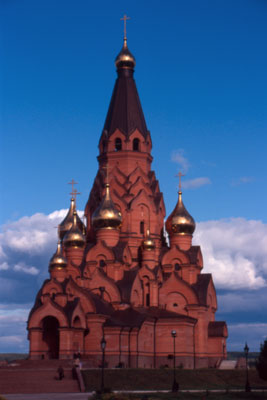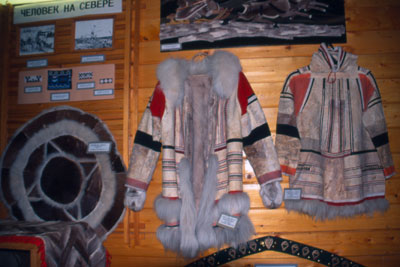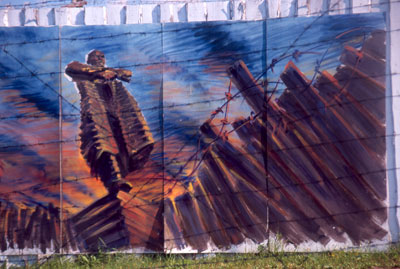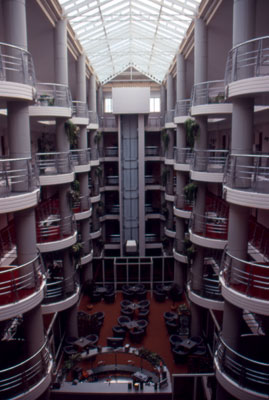Venturing into Siberia, plus a cruise on Russia’s Yenisei River
by Bill Altaffer, Carmel Valley, CA
During the ’60s, ’70s and ’80s I did not look forward to visiting Soviet Russia. Traveling there was difficult, the hotels and restaurants were uncomfortable and inhospitable, and destinations were highly controlled. It was an ordeal rather than a pleasure. Today, I can’t get enough of Russia.
I look forward with great anticipation to warm service and fine dining in creative, original boutique restaurants and to the high thread count of designer sheets on hotel beds complemented by the marble décor and modern fixtures in the bathrooms.
On this latest trip, our hotel in Moscow was the newly renovated Peter I, within walking distance of Red Square. Its indoor swimming pool and spa rival the best anywhere in the world.
More importantly, traveling to most locations in Russia, though still controlled, to some extent, is now possible with advance preparation.
Russia’s military past
Because the seven members of our small group, plus tour manager extraordinaire Paul Schwartz, all were veterans of Russian travel, our organized excursions in Moscow avoided the obvious sites. Instead, we visited the Monino aviation museum (advance permission and permits required), a prime stop for anyone interested in airplanes and air flight history, though it’s rarely included in tour itineraries.
Located at a former Soviet Air Force base, the museum, which is mostly open air with hangars housing very old and unique aircraft, is the largest in Russia. It includes the famous Tupolev Tu-95 (a huge Cold War bomber called the “Bear”), plenty of MiGs and Yaks and the world’s largest helicopter, the Mil Mi-12. Also featured is a multitude of experimental aircraft with unique designs as well as the plane that carried Khrushchev to America, a monster of an aircraft.
Even the members of our group who had little knowledge of, or interest in, airplanes were fascinated with what we saw, and they appreciated the diversity and variety of the aircraft on display.
As a contrast to the warm, sunny morning we enjoyed at Monino, we spent the evening 200 feet below Moscow in the secret, secured command post Tagansky, an abandoned relic of the Cold War. Originally built to withstand nuclear attack, the 75,000-square-foot space could have sustained 3,000 people for three months. Ordered by Stalin in 1951, it took five years to build.
An interesting film on the Cold War from the Soviet perspective was shown by a guide dressed in period army uniform. Then, following a quite realistic simulated attack by the “Imperialistic West,” our dinner was served in the bunker.
Perm Krai
The next day we flew to Perm Krai, a somewhat autonomous region. The entire area and its capital city, Perm, were not included in my 1990 edition of Lonely Planet’s USSR guide. In fact, most of the places on our journey, which eventually reached deep into the Arctic Circle, were off-limits to any foreigner until recently and still require special advance permission.
Reflecting so many of the positive changes one sees in Russia today, our aircraft from Moscow to Perm was new and modern. The two-hour flight (including a two-hour time change) was on Sibir Airlines (operating as S7 Airlines) rather than on a government-owned airline.
Known as the Gateway to Siberia, Perm is located in the western foothills of the Ural Mountains on the Kama River. As we found everywhere else that we traveled in Russia, the people of Perm were very friendly and helpful. Our local guide, Ekaterina, did an outstanding job and had an excellent command of the English language.
The countryside of Perm Krai is idyllic, and we drove through it on bumpy roads for about 60 miles to Perm 36, the only intact gulag facility left in Russia. Now a small museum, it is a powerful reminder of a dark period in Russia’s history and is being preserved and restored by people dedicated to keeping this history alive so it will not be repeated.
At one time, there were more gulags in Russia than villages. The inhumane living conditions, starvation and torture that existed in the gulags were horrific beyond comprehension. After touring the facilities, we watched a well-done, informative documentary in English that detailed some of the awful conditions of Perm 36.
Following this sobering experience, we drove another 60 miles or so to the village of Kungur, on the banks of the Sylva River, for something completely different: the Kungur Ice Caves. This giant complex of underground lakes, frozen waterfalls and colonies of huge ice crystals is estimated to be over 10,000 years old.
We bundled up in our warmest gear and spent nearly two hours enthralled by the many caverns and beautiful ice formations of this unique cave system.
At the end of the day, we returned to Perm in time for dinner in the home of a local resident. Our tour company, MIR Corporation, provides home dining as a feature of most of their tours, and these often are the most memorable experiences of a MIR trip. You are able to meet real, ordinary people in their own homes, see how they really live, eat the foods they eat and communicate and share ideas with them. I always end up with a completely different, more in-depth understanding of Russia than I could ever have otherwise.
Our hostess in Perm spoke excellent English, besides being an outstanding cook. It was, as usual, a highlight of the trip.
On to Omsk
After an afternoon spent at Khokhlovka Village, home to an open-air Museum of Wooden Architecture located outside the city, we boarded our superior sleeping car on the evening train to Omsk, our first train journey of the trip. During the night, we crossed over the Ural Mountains into Siberia. We relaxed on the train the whole next day as we sped through the Siberian countryside, arriving at Omsk in the evening.
Founded in 1716, Omsk is a pleasant city nestled between the Om and Irtysh rivers. It is best known as the place Dostoevsky spent his four-year exile after his mock execution in St. Petersburg in 1849.
We enjoyed a city tour that included beautiful renovated churches, a theater and museums, ending the afternoon on a riverboat with a huge crowd of locals enjoying the beautiful Sunday weather. Our local guide told us that we were the first American travelers she had ever led, something that we heard often during the rest of our trip.
Novosibirsk
The entire next day was spent driving 400 miles to Novosibirsk. Only when you travel by road and train across Siberia can you begin to appreciate the massiveness of this land. Most of the countryside we saw that day was relatively flat, with some woods and uncounted acreages of fields of rich black earth planted thickly with grain, rapeseed and sunflowers.
The road was in very good shape. Though it was heavy with traffic, we were able to make good time for most of the drive.
Since studying Russian geography in college, I have had a fascination with Novosibirsk (New Siberia). It was the fulfillment of a long-held dream to finally arrive there. I was not disappointed.
Novosibirsk is a very modern city, with all the amenities of Moscow. Its beautiful train station, from the “constructionist” era of Soviet architecture, contrasts with gleaming, almost futuristic skyscrapers.
Triple entrance doors in many buildings are testaments to the extreme winters in the area, when temperatures commonly reach -60°F. In summer they can reach more than 115°F.
Our hotel in the city was an old 3-star Intourist hotel, the Ibis Sibir. It was very comfortable, with international TV, air-conditioning, a pool and, of course, a sauna.
Our city tour included a visit to the world’s only birch bark museum. I’ve seen birch bark crafts all over Russia but nothing that compared to the amazingly creative items on exhibit here, objects both useful and strictly artistic.
Tomsk
The following morning, we loaded into a van for our five-hour drive through flat, green land to Tomsk. Founded in 1604, its one of the oldest cities in Siberia.
We enjoyed the afternoon and the next day in this very pleasant city. We saw the largest bell in Siberia, went into a beautiful Russian Orthodox church where several babies were being baptized, visited numerous neighborhoods packed with many examples of traditional Siberian wooden architecture and climbed to the top of an old fire watchtower for a scenic view of the entire city.
In the afternoon of our second day in Tomsk, we caught a commuter train to connect to the Trans-Siberian Railroad. We were an unusual experience for the commuters. One man insisted on sharing his beer with us, thrilled to be meeting his very first Americans.
We eventually boarded our sleeper car on the Trans-Sib for our overnight trip to Krasnoyarsk, arriving in the morning. We were joined there by our local guide, Olga, and transferred directly to the airport.
Norilsk
Olga, who did not speak English, was intense and efficient, facilitating all our experiences over the next few days. Olga’s mission was to inform, entertain and educate us, which she did in daily lectures and informal discussions, assisted by Paul’s helpful translations.
Her first duty was to deal with airport officials. We jumped through several bureaucratic hoops before being allowed to fly on a government jet to Norilsk, high above the Arctic Circle.
Though we had all the requisite paperwork giving us permission to visit this semiclosed city, we were not allowed through security until it had been closely examined by several different airport officials. Norilsk, as was true for most of the cities on our trip, was not even noted on old Soviet maps or mentioned in older guidebooks.
Our arrival at the airport outside of Norilsk was marked by additional security and screening. Long after we had dealt with that red tape, we were still waiting for our luggage as it was x-rayed and examined before finally being released to the waiting crowd.
As we drove toward the city, the landscape became bleaker and grimmer with each passing minute. Norilsk has been listed among the top 10 most polluted cities on the planet. It was built on permafrost for the single purpose of exploiting the rich deposits of nickel, copper and other precious metals that lie under the frozen ground. These ores are mined and processed in huge factories whose smokestacks billow clouds of toxic particles into the air 24 hours a day.
There is talk about eventually making these factories more environmentally responsible; in the meantime, the air stinks and the acid rain continues to kill all the trees and other vegetation in the area. Wildlife, of course, is nonexistent.
I could not get over the fact that people actually live in such a poisonous environment. By the time we arrived at our hotel in the city, I was convinced that Norilsk is the worst-possible place on Earth for people to live.
No one in our group would ever want to return to Norilsk, but none of us was sorry we went there. Sometimes there are prices to pay for going where few dare to visit. I feel we experienced something completely unique and will never forget it. But I was very, very happy that we spent only 24 hours there.
On the river
As we left Norilsk and drove on one of the few local roads in the area to the town of Dudinka, the countryside gradually became less damaged by pollution. Vegetation grew on the tundra and birds flew in the air.
After a couple of hours on the road, we arrived at Dudinka,where we boarded our Spartan vessel, the Valery Chkalov, for a five-day cruise up the Yenisei River. The Yenisei, like many Siberian rivers, flows from southern regions to empty into the Arctic Ocean. Having originated in Mongolia, it is the world’s fifth-longest river, something over 2,550 miles long (sources vary).
The Valery Chkalov was built over 60 years ago, when, no doubt, it was a first-class ship. Today, it’s not a tourist vessel but is owned by the Norilsk Nickel company.
During ice-free months, it and a sister ship make regular round trips between Krasnoyarsk and Dikson, providing the only affordable transport for factory workers and the inhabitants of the small villages located on the river. At most of these villages the ship did not stop; rather, it slowed down so that small motorboats could pull up to deliver or retrieve passengers.
The ship boasts four levels of service. We were in the first-class cabins, which were very tiny and basic. Our toilet facilities were down the hall, and showers (private for our group) were on the deck below.
Olga had the key to a lounge area that was for our exclusive use. There, we could relax, read, listen to Olga’s lectures and watch videos of the area. Since there were no electrical outlets in the cabins, this room was where we recharged all our batteries.
Fourth-class passengers did not have cabins. They slept wherever they could — on deck or on the two small couches at reception. Very few of the ship’s passengers were able to afford meals in the dining room, which we usually had to ourselves. The food on board was excellent, well prepared, varied and tasty.
We made only two stops where we were able to disembark briefly. The first was at the town of Igarka, where we made a quick dash to see its permafrost museum. It was fascinating. Considering its remote location, we were surprised to find that it had beaten London’s National Portrait Gallery, among others, for special commendation in 2002 by the European Museum Forum.
Our second stop was even shorter, at a small village where most passengers disembarked in a rush to hurriedly buy assorted foods and goods at tables set up by local entrepreneurs on the shore. Items for sale included buckets of berries, cedar nuts, homemade jams and hot sauces.
On our last full day on the ship, Olga took us to the bridge, where we were given champagne and certificates as we crossed the Arctic Circle.
Modernization
After covering nearly 1,000 miles by ship, we arrived back in Krasnoyarsk. We spent one night there in an ultramodern hotel, notable because all the mini-bar items were free of charge. The following day, we enjoyed a leisurely, very interesting tour of this charming city.
We also took a 20-minute drive out of town to a state-of-the-art ski resort, complete with Doppelmayr high-speed quad ski lifts that race up the mountain slopes all year ’round. The latest snow-making equipment lined the sides of the slopes. That plus temperatures as low as -50°F assure a good skiing season.
That night we flew back to Moscow, gaining four hours and arriving at the Vnukovo International Airport at 9 p.m. The drive from this airport to downtown Moscow at night was incredible. The city appeared enchanted, very much like in a fairy tale, with picturesque buildings and onion-domed churches lit up colorfully and beautifully. It was an almost dream-like sight — a fitting end to our trip.
Russia remains a fascinating place, to me. It has such a long, sad, hard history. Its people have suffered through incredibly difficult times, yet they remain warm, welcoming and strong.
After 12 trips to Russia, starting in 1964, I think that I am finally beginning to understand this multifaceted nation. It still has cities closed to tourism, but it also has very open and engaging people, beautiful countryside, unique architecture in historical cities, excellent food and plenty of attractions to appeal to all tastes and interests.
The country is changing rapidly in many ways as it joins the modern world. Our group saw many differences between this visit and what many of us had experienced just a year before. For example, the women in our group noted that almost all the public toilets now carry toilet paper and have soap and running water. Even a mere year ago, very few of them did.
Russia is invigorating. It is rich in history and has been vitalized by a free market. Things are happening there at a very fast pace, and you can see it reflected in the people you meet. Now, Russians travel the world and are knowledgeable and informed about events outside of their borders. Cities and towns across the vast landscape host excellent hotels, restaurants and resorts, all with the most modern amenities. Only by going there will you know the excitement of experiencing today’s Russia.
Whether you are making your first visit to Russia and want a “normal” itinerary to the obligatory spots or want to explore some of the innumerable, rarely visited, remote areas of the country, I highly recommend MIR Corporation (Seattle, WA; 800/424-7289).
My Aug. 17-Sept. 5, 2009, escorted tour cost $11,995, including internal air transfers, land transportation, all meals and the Yenisei River cruise.

